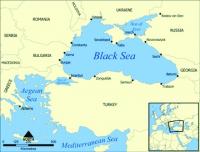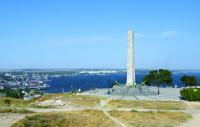This week, the Wehrmacht launched its final assault against the Black Sea Port of Kerch, on the Crimea Peninsula. At 2600 years of age, Kerch is the oldest city in the Crimea. It is located on the Kerch Peninsula in the eastern part of the Crimean Peninsula and today has a population of 150,000.
This was the second time that Axis forces had captured this city. On November 6, 1941, the 45th Division, commanded by Knight’s Cross holder, Lt. Gen. Count Hans Sponeck, captured the city, driving its defenders across the Kerch Strait to the Taman Peninsula. On December 26, 1941, the Soviet 51st Independent Army, under the command of Lt. Gen. Vladimir N. L’vov, together with the 44th Army, commanded by General Aleksei Pervushin, landed on the Kerch Peninsula, and on December 30th recaptured the city. This maneuver saved, for the time being, Sevastopol, home of the Soviet Black Sea fleet. The German 11th Army, commanded by Erich von Manstein, suffered 8595 casualties while the Red Army lost 7000 killed and 20,000 captured.
In the meantime, General von Sponeck had, against von Manstein’s orders, extricated his division from a potential trap of annihilation, and with the aid of some Romanian units, held the Red Army off of the rest of the 11th Army as it was trying to subdue Sevastopol. Instead of being lauded for his quick action in saving his division from destruction and later holding the line so that 11th Army was not attacked from the rear, he was court-martialed. His trial began on January 23, 1942. Luftwaffe Chief, Reichsmarshal Herman Göring, served as Court President. Although Count von Sponeck was convicted and sentenced to death, Hitler reduced the sentence to six years incarceration. Even so, after the failed attempt on der Führer’s life of July 20, 1944, he was shot, under orders from SS Reichsführer, Heinrich Himmler.
The Soviets re-enforced the Kerch defenders and its defenses between January 20th and February 11th.
Feodosia was recaptured, in January 1942, by the Wehrmacht. This seaside resort of 85,000 is 2500 years old. Its 3,248 Jewish citizens were murdered by Einsatzgruppe-D, commanded by Dr. Otto Ohlendorf, who was hanged for his crimes, at Landsberg Prison, in Bavaria, on June 8, 1951.
Dimitry Kozlov took command of the forces defending Kerch, now designated the Crimean Front, on January 28th. The Front consisted of: the 44th Army, now commanded by Maj. Gen. Konstantin S. Kolganov, since General Pervushin had been severely wounded; 51st Independent Army, still commanded by Lt. Gen. L’vov; and the 47th Army, commanded by Konstantin Fedorivich Baronov. In February, General Baronov was replaced by General Stepan Ivanovich Cherniak. He and General Kolganov then exchanged commands.
On April 11, 1942, the Red Army unsuccessfully attempted to retake Eupatoria. The 2500-year-old city today has a population of 123,000.
Axis Forces were reinforced by Luftflotte 4, under the command of Knight’s Cross holder Alexander Löhr. With the arrival of the Luftwaffe’s Luftflotte 4, the Soviet shipping began to suffer considerably. Six transports were sunk, together with a mine layer, a mine sweeper, a torpedo boat. Six other transports were temporarily put out of service.
At 4:15 A.M. on May 8th the Axis’ assault against Kerch began. Defending the city were 250,000 Soviet soldiers spread among the following: General L’vov’s 51st Independent Army; General Cherniak’s 44th Army; and General Kolganov’s 47th Army. By now, Stalin had placed the defending Soviet forces under the command of one of his incompetent cronies, People’s Commissar Lev Mekhlis. He was never again sent into the field.
Although outnumbered two to one, the advantage the Germans did have, in addition to superior leadership, was Fliegerkorps VIII, under the command of Knight’s Cross holder General Dr. Baron Wolfram von Richthofen. The ground attack tactics which Baron von Richthofen had first used in Spain, and perfected in Poland, France and Greece, were used to great effect against Kerch, and later Sevastopol. General von Manstein said that these tactics, "...pulled the infantry forward...," through successive Soviet defensive positions.
General von Manstein’s Eleventh Army consisted of the following: five infantry divisions, divided between the XXX and XXXXII Armeekorps, commanded by Knight’s Cross holders Maximilian Fretter-Pico and Franz Mattenklott; the 22nd Panzerdivision commanded by Knight’s Cross holder Wilhelm von Apell; and three divisions in the VII Romanian Corps commanded by Florea Mitrãnescu.
Within three and a half hours after the assault was launched, General Cherniak’s 44th Army collapsed. On May 9th General von Manstein sent in General von Apell’s panzers, which destroyed the 51st Independent Army, killing General L’vov. On May 20th Kerch fell. It would remain under German occupation until April 11, 1944. During that time 15,000 of the city’s citizens died and another 14,000 were "deported."
Although 90,000 Soviet soldiers were evacuated, 162,282 were killed or captured, together with the loss of 4,646 guns and mortars, 496 tanks and 417 aircraft. The Axis casualties amounted to only 3,397, together with the loss of 12 guns and eight tanks. The Kerch operation had delayed the capture of Sevastopol, and subsequent redeployment of Eleventh Army - and its brilliant leader, Erich von Manstein - to either the siege of Leningrad or the Caucuses operation, by six crucial months.
Now, General von Manstein could concentrate his efforts on taking the great port of Sevastopol. During the operations against Kerch and Sevastopol, Generals von Manstein and von Richthofen formed one of the greatest duos warfare has seen - along the lines of Robert E. Lee and "Stonewall" Jackson during the War of Northern Aggression.
On September 14, 1973, Kerch and Novorossiysk were named Hero Cities of the Soviet Union. They joined Leningrad, Stalingrad, Sevastopol, Odessa, Kiev and Moscow. They would be joined later by Minsk, Tula, Murmansk and Smolensk.
NEXT WEEK: SECOND BATTLE OF KHARKOV
Mr. Wimbrow writes from Ocean City, Maryland, where he practices law representing those persons accused of criminal and traffic offenses, and those persons who have suffered a personal injury through no fault of their own. Mr. Wimbrow can be contacted at
wimbrowlaw@beachin.net

